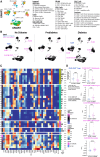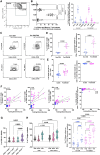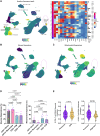CD3+ T-cell: CD14+ monocyte complexes are dynamic and increased with HIV and glucose intolerance
- PMID: 40073149
- PMCID: PMC11952877
- DOI: 10.1093/jimmun/vkae054
CD3+ T-cell: CD14+ monocyte complexes are dynamic and increased with HIV and glucose intolerance
Abstract
Persistent systemic inflammation is associated with an elevated risk of cardiometabolic diseases. However, the characteristics of the innate and adaptive immune systems in individuals who develop these conditions remain poorly defined. Doublets, or cell-cell complexes, are routinely eliminated from flow cytometric and other immune phenotyping analyses, which limits our understanding of their relationship to disease states. Using well-characterized clinical cohorts, including participants with controlled human immunodeficiency virus (HIV) as a model for chronic inflammation and increased immune cell interactions, we show that circulating CD14+ monocytes complexed to CD3+ T cells are dynamic, biologically relevant, and increased in individuals with diabetes after adjusting for confounding factors. The complexes form functional immune synapses with increased expression of proinflammatory cytokines and greater glucose utilization. Furthermore, in persons with HIV, the CD3+ T cell: CD14+ monocyte complexes had more HIV copies compared to matched CD14+ monocytes or CD4+ T cells alone. Our results demonstrate that circulating CD3+ T-cell: CD14+ monocyte pairs represent dynamic cellular interactions that may contribute to inflammation and cardiometabolic disease pathogenesis. CD3+ T-cell: CD14+ monocyte complexes may originate or be maintained, in part, by chronic viral infections. These findings provide a foundation for future studies investigating mechanisms linking T cell-monocyte cell-cell complexes to developing immune-mediated diseases, including HIV and diabetes.
Keywords: CD3+; HIV; T-cell: CD14+; diabetes; doublets; monocyte complexes; reservoir.
© The Author(s) 2025. Published by Oxford University Press on behalf of The American Association of Immunologists.
Conflict of interest statement
The authors have no competing interests.
Figures








Update of
-
CD3+ T-cell: CD14+monocyte complexes are dynamic and increased with HIV and glucose intolerance.bioRxiv [Preprint]. 2024 Jun 20:2023.04.24.538020. doi: 10.1101/2023.04.24.538020. bioRxiv. 2024. Update in: J Immunol. 2025 Mar 1;214(3):516-531. doi: 10.1093/jimmun/vkae054. PMID: 37162990 Free PMC article. Updated. Preprint.
References
MeSH terms
Substances
Grants and funding
- R03HL155041/Burroughs Wellcome Fund
- The Myositis Association Pilot Award
- 1021480/Burroughs Wellcome
- DK058404/Vanderbilt Digestive Disease Research Center
- DRTC Alzheimer's Disease Pilot & Feasibility Program
- NH/NIH HHS/United States
- Silicon Valley Community Foundation
- KL2TR002245/Tennessee Center for AIDS Research
- R01HL144941/Burroughs Wellcome Fund
- K23 HL159351/HL/NHLBI NIH HHS/United States
- P30 AI110527/AI/NIAID NIH HHS/United States
- P30 DK058404/DK/NIDDK NIH HHS/United States
- DK020593/NH/NIH HHS/United States
- Vanderbilt Flow Cytometry Shared Resource
- NIH
- 2022- 253529/CZI Science Diversity
- 1021868.01/Burroughs Wellcome Fund
- K08AR080808/Tennessee Center for AIDS Research
- R01 DK112262/DK/NIDDK NIH HHS/United States
- Vanderbilt Diabetes and Research Training Center
- UNCF
- 5UL1TR002243-03/Clinical Translational Science
- R25 HL106365/HL/NHLBI NIH HHS/United States
- K08 AR080808/AR/NIAMS NIH HHS/United States
- P30 DK020593/DK/NIDDK NIH HHS/United States
- P30 CA068485/CA/NCI NIH HHS/United States
- Bristol-Myers Squibb
- R03 HL155041/HL/NHLBI NIH HHS/United States
- UL1 TR002243/TR/NCATS NIH HHS/United States
- #1022376/Burroughs Wellcome Fund
- CSDA 2021193/Doris Duke
- K23 HL156759/HL/NHLBI NIH HHS/United States
- 5R25HL106365-12/Small Research Pilot Subaward
- Chan Zuckerberg Initiative DAF
- 1021480/Burroughs Wellcome Fund
LinkOut - more resources
Full Text Sources
Medical
Research Materials

